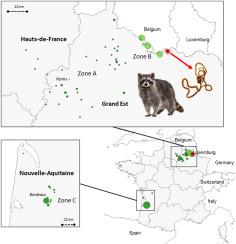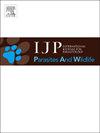Surveys on Baylisascaris procyonis in two of the three French wild raccoon populations
Abstract
Human infection by Baylisascaris procyonis can result in larva migrans syndromes, which can cause severe neurological sequelae and fatal cases. The raccoon serves as the definitive host of the nematode, harboring adult worms in its intestine and excreting millions of eggs into the environment via its feces. Transmission to paratenic hosts (such as rodents, birds and rabbits) or to humans occurs by accidental ingestion of eggs. The occurrence of B. procyonis in wild raccoons has been reported in several Western European countries. In France, raccoons have currently established three separate and expanding populations as a result of at least three independent introductions. Until now the presence of B. procyonis in these French raccoon populations has not been investigated. Between 2011 and 2021, 300 raccoons were collected from both the south-western and north-eastern populations. The core parts of the south-western and north-eastern French raccoon populations were free of B. procyonis. However, three worms (molecularly confirmed) were detected in a young raccoon found at the edge of the north-eastern French raccoon population, close to the Belgian and Luxemburg borders. Population genetic structure analysis, genetic exclusion tests and factorial correspondence analysis all confirmed that the infected raccoon originated from the local genetic population, while the same three approaches showed that the worms were genetically distinct from the two nearest known populations in Germany and the Netherlands. The detection of an infected raccoon sampled east of the northeastern population raises strong questions about the routes of introduction of the roundworms. Further studies are required to test wild raccoons for the presence of B. procyonis in the area of the index case and further east towards the border with Germany.


 求助内容:
求助内容: 应助结果提醒方式:
应助结果提醒方式:


